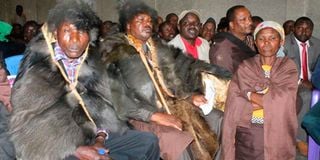The Ogiek mark another African court judgment with no justice in sight

Members of the Ogiek community follow proceedings in Nakuru Town on February 6, 2019 during a meeting of the taskforce on the implementation of the decision of the African Court on Human and People's Rights on their occupation of Mau Forest land.
Former Law Society of Kenya (LSK) president Isaac Okero warned that the government risked exposing the country to anarchy and a state of lawlessness if they continued the flagrant disobedience of court orders.
And we need to take this seriously, especially for a democratically elected government, four years is a very long time to delay the implementation of a decision of an important court like the African Court on Human and Peoples’ Rights.
On May 26, 2017, the court issued a significant judgment that asserted and recognised the rights of the Ogiek to their ancestral land and their role in protecting and conserving the land and its natural sources.
Unfortunately, four years later, the Ogiek continue facing threats and eviction notices despite this crucial judgment. The government created a task force to help with implementing this judgment which seemed to be a step in the right direction, albeit a step that is reminiscent of the President Daniel arap Moi regime.
Admirers of the late President Moi often marveled at his political genius – more bluntly, the ability to use commissions of inquiry to give the public the impression that something was happening when the opposite was often the case if not the intended outcome.
Delayed justice
The same tactics are being used to deny indigenous and local communities a chance to live at peace on their ancestral land through protracted and delayed justice mechanisms.
Sadly, the Ogiek continue to fight to keep their ancestral land and means of livelihood as the government relentlessly seeks to evict them – even during this pandemic period and sometimes when it is raining.
The prevalent notion of top-down protection models doesn’t allow effective partnerships with the community. This archaic mentality that the Ogiek must leave the Mau to conserve the forest is misguided at best and mischievous at worst.
It is mischievous because the government has access to data that shows indigenous communities conserve the forests better. They also have data to show fortress conservation approach, if anything, gives opportunity to conservation ills like poaching because the poachers have only one person (or institution to deal with) compared to an entire community and their traditional governance system that depends on that forest.
As we continue to see gross negative impacts from climate change, an increasingly alarming rate of biodiversity loss, the global community has started to recognise the role of indigenous people in safeguarding this same climate and biodiversity.
Natural resources
Communities have long histories of expertise in sustainable use and management of natural resources; we are remiss as a country if we do not take advantage of this same expertise and arm communities with the security through legally recognised land tenure and bolster the efforts of the government.
The concept of ‘boots on the ground’ is precisely the support that community members are willing to provide for a government that claims to be stretched and unable to effectively protect and conserve our essential resources and biodiversity.
In Tanzania, where the government has embraced indigenous methods of conserving the forests, the results are remarkable, we have great examples both regionally and globally that this can work, and why do we still hesitate?
The resilience of the Ogiek community is seen in their eight-year-long legal battle that saw the African Court on Human and Peoples’ Rights deliver a landmark ruling in their favour.
The court ruled that regularly subjecting the Ogiek community to arbitrary forced evictions from their ancestral lands in the Mau Forest was a violation. The government of Kenya had violated seven separate articles of the African Charter, including their right to property, natural resources, development, religion, culture, and non-discrimination.
Human rights
Having the same conversation four years after this decision indicates glaring proof of the government’s inconsistencies when it comes to safeguarding human rights.
Six months after the ruling, the government set up the task force in November 2017 to report in May 2019, only to push it to October 2019 – meanwhile, the Ogiek continued facing the same challenges.
With the task force set to present their report in January 2020 and then March 2020, the expectation was that finally, justice would be done, but nothing has happened since, with no publicly available taskforce report.
How long are we as citizens meant to wait before justice is served? Isn’t it clear that delaying justice is effectively denying it, as the famous maxim goes?
The Kenyan government is obligated to provide a duty of care to its citizens; this includes recognising their right to self-determination. The Constitution of Kenya in Article 63 already sets out the rights that are available to our indigenous people and local communities in Kenya. Respecting the right of these same communities to own, use, protect, conserve, and benefit from the resources they have responsibly protected is crucial to the government.
Violating court orders
In the words of the former KLS President, the government should be careful about violating court orders and ignoring court judgments because when the law loses its meaning and effect, then anarchy becomes a reality.
We are a country guided by the rule of law. Let this year be the last year the Ogiek have to mark another anniversary of a judgment that they don’t know when it will be implemented. For a start, make the task force report public.




